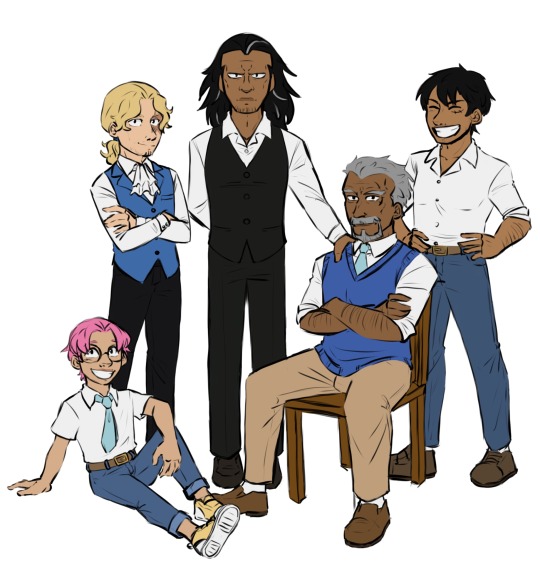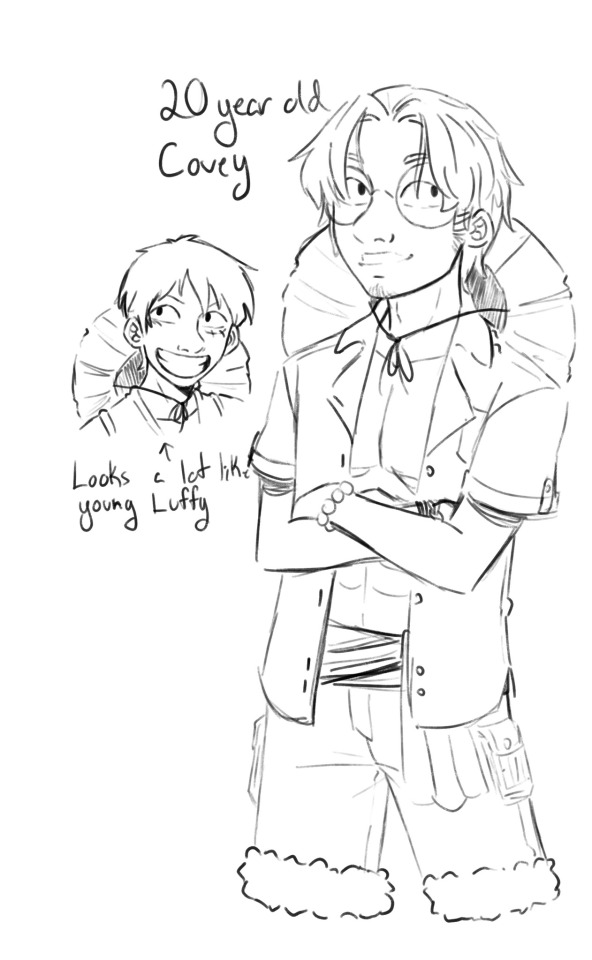#monkey d covey
Text

Monkey D family photo! Who got them to dress up and behave for long enough to actually get a good picture? I have no clue! And Sabo’s there because he’s like double adopted, and if we knew more about Ds I would even say he’d go by Monkey(or Portgas) D Sabo. I digress though
#ace would be there too if he weren’t ya know#when I started this I was so sure I wasn’t gonna color it#would’ve been easier that’s for sure#one piece#one piece original character#one piece oc#monkey d. luffy#one piece sabo#revolutionary sabo#monkey d garp#monkey d dragon#monkey d covey#garp one piece#dragon one piece
59 notes
·
View notes
Text
Interesting Papers for Week 10, 2022
On the relationship between maps and domains in inferotemporal cortex. Arcaro, M. J., & Livingstone, M. S. (2021). Nature Reviews Neuroscience, 22(9), 573–583.
An observer model of tilt perception, sensitivity and confidence. Arnold, D. H., Saurels, B. W., Anderson, N. L., & Johnston, A. (2021). Proceedings of the Royal Society B: Biological Sciences, 288(1956), 20211276.
Experience‐related enhancements in striatal temporal encoding. Bruce, R. A., Weber, M. A., Volkman, R. A., Oya, M., Emmons, E. B., Kim, Y., & Narayanan, N. S. (2021). European Journal of Neuroscience, 54(3), 5063–5074.
What happened? Do preschool children and capuchin monkeys spontaneously use visual traces to locate a reward? Civelek, Z., Völter, C. J., & Seed, A. M. (2021). Proceedings of the Royal Society B: Biological Sciences, 288(1956), 20211101.
Chronic Augmentation of Endocannabinoid Levels Persistently Increases Dopaminergic Encoding of Reward Cost and Motivation. Covey, D. P., Hernandez, E., Luján, M. Á., & Cheer, J. F. (2021). Journal of Neuroscience, 41(32), 6946–6953.
A transient postnatal quiescent period precedes emergence of mature cortical dynamics. Domínguez, S., Ma, L., Yu, H., Pouchelon, G., Mayer, C., Spyropoulos, G. D., … Gelinas, J. N. (2021). eLife, 10, e69011.
Causal Inference Gates Corticostriatal Learning. Dorfman, H. M., Tomov, M. S., Cheung, B., Clarke, D., Gershman, S. J., & Hughes, B. L. (2021). Journal of Neuroscience, 41(32), 6892–6904.
Astrocyte-derived neurons provide excitatory input to the adult striatal circuitry. Dorst, M. C., Díaz-Moreno, M., Dias, D. O., Guimarães, E. L., Holl, D., Kalkitsas, J., … Göritz, C. (2021). Proceedings of the National Academy of Sciences, 118(33), e2104119118.
Working memory representations in visual cortex mediate distraction effects. Hallenbeck, G. E., Sprague, T. C., Rahmati, M., Sreenivasan, K. K., & Curtis, C. E. (2021). Nature Communications, 12, 4714.
Single caudate neurons encode temporally discounted value for formulating motivation for action. Hori, Y., Mimura, K., Nagai, Y., Fujimoto, A., Oyama, K., Kikuchi, E., … Minamimoto, T. (2021). eLife, 10, e61248.
An image-computable model of how endogenous and exogenous attention differentially alter visual perception. Jigo, M., Heeger, D. J., & Carrasco, M. (2021). Proceedings of the National Academy of Sciences, 118(33), e2106436118.
Resonating neurons stabilize heterogeneous grid-cell networks. Mittal, D., & Narayanan, R. (2021). eLife, 10, e66804.
Holistic face recognition is an emergent phenomenon of spatial processing in face-selective regions. Poltoratski, S., Kay, K., Finzi, D., & Grill-Spector, K. (2021). Nature Communications, 12, 4745.
Theta-phase dependent neuronal coding during sequence learning in human single neurons. Reddy, L., Self, M. W., Zoefel, B., Poncet, M., Possel, J. K., Peters, J. C., … Roelfsema, P. R. (2021). Nature Communications, 12, 4839.
Direct extraction of signal and noise correlations from two-photon calcium imaging of ensemble neuronal activity. Rupasinghe, A., Francis, N., Liu, J., Bowen, Z., Kanold, P. O., & Babadi, B. (2021). eLife, 10, e69736.
Systematic spatial distortion of quantitative estimates. Shaki, S., & Fischer, M. H. (2021). Psychological Research, 85(6), 2177–2185.
Recurrent dynamics in the cerebral cortex: Integration of sensory evidence with stored knowledge. Singer, W. (2021). Proceedings of the National Academy of Sciences, 118(33), e2101043118.
Abrupt hippocampal remapping signals resolution of memory interference. Wanjia, G., Favila, S. E., Kim, G., Molitor, R. J., & Kuhl, B. A. (2021). Nature Communications, 12, 4816.
Causal neural mechanisms of context-based object recognition. Wischnewski, M., & Peelen, M. V. (2021). eLife, 10, e69736.
Guided Search 6.0: An updated model of visual search. Wolfe, J. M. (2021). Psychonomic Bulletin & Review, 28(4), 1060–1092.
#science#Neuroscience#computational neuroscience#Brain science#research#neurons#neural networks#neural computation#neurobiology#cognition#cognitive science#psychophysics#scientific publications
11 notes
·
View notes
Link
Hey guys.I wanted to share my blog with you, which is just summaries of best selling business books. I think you can get value from it, if there’s a specific book you wanted to check out, but just didn’t have time to do it yet.Each summary takes 5-10 min to read. Some of them have a 1-minute version summary and diagrams as well.https://medium.com/@FranticRockThe theory is: if something is not “juicy-enough” in the book, then it doesn’t make the summary. I only summarize non-fiction business books, and self-improvement books. Disclaimer: these are re-summarized form another summarization service, which are about 2x as long to read.Please let me know your feedback and consider following me on Medium, so you can get notified as I write new ones. Here’s the current list of books on there (I write more whenever I get time):The Inevitable (Kevin Kelly)Purple Cow (Seth Godin)Crossing the Chasm (Geoffrey A. Moore)The Millionaire Fastlane (MJ DeMarco)The Four (Scott Galloway)The ONE Thing (Gary Keller and Jay Papasan)Benjamin Franklin (Walter Isaacson)Crushing It! (Gary Vaynerchuk)The Age of Cryptocurrency (Paul Vigna, Michael J. Casey)Think Like a Freak (Steven D. Levitt and Stephen J. Dubner)Super Freakonomics (Steven D. Levitt and Stephen J. Dubner)Freakonomics (Steven D. Levitt and Stephen J. Dubner)On the Shortness of Life (Lucius Annaeus Seneca)Steve Jobs (Walter Isaacson)Digital Gold (Nathaniel Popper)Radical Candor (Kim Scott)Deep Work (Cal Newport)The Lean Startup (Eric Ries)The Rational Optimist (Matt Ridley)The Happiness Hypothesis (Jonathan Haidt)Leadership BS (Jeffrey Pfeffer)The One Device (Brian Merchant)The 7 Habits of Highly Effective People (Stephen R. Covey)The Innovators (Walter Isaacson)Chaos Monkeys (Antonio Garcia Martinez)On Writing Well (William Zinnser)Elon Musk (Ashlee Vance)Pre-suasion (Robert Cialdini)Crush It! — Gary VaynerchukBird by Bird (Anne Lamott)Learn Better (Ulrich Boser)The Thank You Economy (Gary Vaynerchuk)Business Model Generation (Alexander Osterwalder & Yves Pigneur)“The Design of Everyday Things” (Donald A. Norman) “Scaling up Excellence” (Robert Sutton, Huggy Rao)Confessions of an Advertising Man (David Ogilvy)Everybody Lies (Seth Stephens-Davidowitz)Business Adventures (John Brooks)“High Performance Habits” (Brendon Burchard)“MONEY: Master the Game” (Tony Robbins)“Unshakeable” (Tony Robbins)“Sapiens” (Yuval Noah Harari)“Quitter” (Jon Acuff)“Principles” (Ray Dalio)“Tools of Titans” (Tim Ferriss)“The 4-hour work week” (Tim Ferriss)“Only the Paranoid Survive” (Andrew Grove)“Zero to One” by Peter Thiel“The Signal and the Noise” (by Nate Silver)“Hatching Twitter” by Nick Bilton“The Hard Thing About Hard Things” - Ben Horowitz“The Four Steps to the Epiphany” - Steve Blank
0 notes
Text
New Post has been published on World Best Lawyers
New Post has been published on http://www.worldbestlawyers.com/maslow-on-my-mind-how-maslows-hierarchy-of-needs-affects-business-and-society-2/
Maslow on My Mind: How Maslow's Hierarchy of Needs Affects Business and Society
Introduction: Maslow in the Big Apple
Abraham Maslow was born in New York in 1908 to poor, uneducated Russian immigrants. He was the oldest of seven children, and therefore pushed by his parents to succeed in education where they had not. Originally studying to be a lawyer, he found it to be of little interest and eventually shifted over to psychology where he excelled. Maslow went on to receive his PhD in Psychology at the University of Wisconsin, under the tutelage of Harry Harlow, famous for experimentation with rhesus monkeys and attachment behavior. After some time he returned to New York and began studying human sexuality. In addition to this study, during the years of teaching, he had the opportunity to meet many well-respected psychologists which further helped to shape his thoughts on the human needs. The final event which led Maslow to move in the humanistic direction came from the study of the development of the concept of “self-actualization”. It was this study that led Maslow to develop his famous Hierarchy of Needs Theory.[1]
Food for thought: What humans really need
Until Maslow began to develop his theories, most studies on human nature focused on biology, achievement or power to explain the forces that drive us.
Maslow postulated that there were five levels of basic needs that every human attempts to attain:
Externally-Satisfied Needs (basic needs that every individual must satisfy before they can progress).
1. Physiological – I’m hungry.
2. Safety – I’m scared.
Internally-Satisfied Needs (needs leading to enlightenment and understanding.
3. Social – I’m lonely.
4. Esteem – I can’t.
5. Self Actualization – I can!
In the 1970s, Maslow further split this hierarchy up into a total of eight levels:[2]
1) Physiological: hunger, thirst, bodily comforts, etc.;
2) Safety/security: out of danger;
3) Belonging and Love: affiliate with others, be accepted; and
4) Esteem: to achieve, be competent, gain approval and recognition.
5) Cognitive: to know, to understand, and explore; (new)
6) Aesthetic: symmetry, order, and beauty; (new)
7) Self-actualization: to find self-fulfillment and realize one’s potential; and
8) Self-transcendence: to connect to something beyond the ego or to help others find self-fulfillment and realize their potential. (new) (This concept is relatively new and many authors such as Dr. Stephen covey express similar views.)[3]
Another way to look at the Needs is to break it into “D-Needs” (Deficiency) and “B-Needs” (Being). Maslow believed that the deficiency needs, once satisfied ceased to be a driving force for the individual, and they were then free to move upward to developing themselves.
If we follow the traditional hierarchical form, we can see that each need forms the basis of the next need above it in the pyramid. Without these previous foundations, Maslow believed that it is impossible to move on to the next stage in the hierarchy.[4]
In spite of the fact that it is very well-known and intrinsically comforting, there seems to be little hard evidence that the theory actually applies to people in general. Even Maslow admitted to this.[5]
A learning experience
Maslow’s Hierarchy of Needs has had a dramatic influence on the field of education. Traditional beliefs regarding educational methodology have shifted to a more humanistic approach, with the focus on meeting the students’ basic needs in order to assist them to progress.
The most important goal in education is to learn, followed by developing an understanding of the material to retain it, and apply it in life. In order to do this, the students need to be motivated enough to work hard to achieve this goal. Without motivation to learn it is unlikely that the education will succeed to the extent that it is intended.
In order to maximize this motivational desire, the educators need to attend to the needs of the student. By understanding Maslow’s Hierarchy of Needs, teachers can work toward realizing the basic needs that develop the foundation for higher learning, or actualization.
Here is an example of how the school can meet the basic needs of the students:
If the school understands that in order to function at school, students need the basic physiological needs satisfied before they can absorb their studies, they may consider providing lunches if a great deal of the students do not have their own. This would then propel the learners to the next level. By fostering a trusting, safe environment, with a classroom social network, and providing praise in the form of positive reinforcement from the teachers, the students will be able to focus on their learning.[6]
A real example that has come up near the end of the 20th century with respect to this is the problems that have arisen due to the beliefs on “special education”. During the 70s and 80s when where the traditional beliefs of segregating children with special needs (physical, intellectual, or emotional) was employed in the school system anomalies arose that called into question these beliefs. It was believed that by placing these students in separate learning atmospheres they would be able to learn at a pace more appropriate to their abilities, receive special attention and eventually progress through the system to receive the same education at the end of the program. As it turns out, this did not happen and the children’s learning was hampered.[7]
Managing expectations
Focusing on such human needs for successful motivation can very easily be ported over to the business world and applied in the field of Management. In fact, Maslow himself became fascinated with the field of management and attempted to explain the ability of good managers to motivate their employees using a solid understanding of the Hierarch of Needs. He even went so far as to regularly visit a high-tech company in California to study the management practices in the 1960s. Maslow discovered that managers who treat their subordinates with trust and respect created an environment that promoted a better work situation and improved productivity.
Peter Drucker, the famous management guru has said that “Maslow’s contribution to management was a big one. He pointed out hat you have to have different personnel policies for different people in different situations for them to be truly effective.”[8]
Why ‘Y’?
Theories X and Y, as developed by Douglas McGregor fit very nicely into the Needs Theory. If humans are intrinsically searching for something to help propel them to the next level, and have an internal desire to progress, and give back to society, as is believed by the followers of “Theory Y”, then it goes to reason that the humanistic approach, as laid out by Maslow would assist these individuals in reaching their goals. If we believe that human nature responds best to a positive, nurturing atmosphere, then managers that hold the following beliefs with respect to their staff should be able to raise them up higher in an attempt to improve productivity, and the individual goals of the worker:
1. Employees view work as natural.
2. Commitment to goals leads to self-direction and self-control.
3. People will look for situations where they can receive accountability for their work.
4. Decision-making on various levels can be spread among the company and not be the sole responsibility of upper management.[9]
What’s ‘Humanism’ got to do, got to do with it?
Humanism is the “third force” in psychology, following the traditional studies of behaviorism and psychoanalysis. Maslow, Carl Rogers, Rolly May and many others helped to advance this way of looking at the human condition.
Humanism has a long history going back to the times of the Greek philosophers of the 6th century BC. It has come forward in time and developed into three broad categories: religious, secular, educational humanism. When people discuss “humanism” they generally mean the understanding of secular humanism.
“Humanism is a broad category of active ethical philosophies that affirm the dignity and worth of all people, based on the ability to determine right and wrong by appeal to universal human qualities— particularly rationality, common history, experience, and belief. Humanism is a component of a variety of more specific philosophical systems, and is also incorporated into some religious schools of thought.
Humanism entails a commitment to the search for truth and morality through human means in support of human interests. In focusing on the capacity for self-determination, humanism rejects transcendental justifications, such as a dependence on faith, the supernatural or divinely revealed texts. Humanists endorse universal morality based on the commonality of human nature, suggesting that solutions to our social and cultural problems cannot be parochial.”[10]
Humanists generally believe the following:[11]
1. Humanism is a philosophy focused upon human means for comprehending reality. Humanists make no claims to possess or have access to supposed transcendent knowledge.
2. Humanism is a philosophy of reason and science in the pursuit of knowledge. Therefore, when it comes to the question of the most valid means for acquiring knowledge of the world, Humanists reject arbitrary faith, authority, revelation, and altered states of consciousness.
3. Humanism is a philosophy of imagination. Humanists recognize that intuitive feelings, hunches, speculation, flashes of inspiration, emotion, altered states of consciousness, and even religious experience, while not valid means to acquire knowledge, remain useful sources of ideas that can lead us to new ways of looking at the world. These ideas, after they have been assessed rationally for their usefulness, can then be put to work, often as alternate approaches for solving problems.
4. Humanism is a philosophy for the here and now. Humanists regard human values as making sense only in the context of human life rather than in the promise of a supposed life after death.
5. Humanism is a philosophy of compassion. Humanist ethics is solely concerned with meeting human needs and answering human problems–for both the individual and society–and devotes no attention to the satisfaction of the desires of supposed theological entities.
6. Humanism is a realistic philosophy. Humanists recognize the existence of moral dilemmas and the need for careful consideration of immediate and future consequences in moral decision making.
7. Humanism is in tune with the science of today. Humanists therefore recognize that we live in a natural universe of great size and age that we evolved on this planet over a long period of time, that there is no compelling evidence for a separable “soul,” and that human beings have certain built-in needs that effectively form the basis for any human-oriented value system.
8. Humanism is in tune with today’s enlightened social thought. Humanists are committed to civil liberties, human rights, church-state separation, the extension of participatory democracy not only in government but in the workplace and education, an expansion of global consciousness and exchange of products and ideas internationally, and an open-ended approach to solving social problems, an approach that allows for the testing of new alternatives.
9. Humanism is in tune with new technological developments. Humanists are willing to take part in emerging scientific and technological discoveries in order to exercise their moral influence on these revolutions as they come about, especially in the interest of protecting the environment.
10. Humanism is, in sum, a philosophy for those in love with life. Humanists take responsibility for their own lives and relish the adventure of being part of new discoveries, seeking new knowledge, exploring new options. Instead of finding solace in prefabricated answers to the great questions of life, Humanists enjoy the open-endedness of a quest and the freedom of discovery that this entails.
What is holding us back?
If reaching the summit of the mountain of self-actualization were easy, everyone would be enlightened, happy, hard-working, creative, and wealthy. We would all strive to take responsibility for our actions, and attempt to improve the situation around us by developing new and unique ideas. Unfortunately, this is not happening. What is holding us back from reaching our “fully functional, healthy personality”?
I concur with Maslow that society and the education system are preventing individuals from reaching their full potential. Here is what Maslow has to say on the matter:
“The state of being without a system of values is psychopathogenic, we are learning. The human being needs a framework of values, a philosophy of life, a religion or religion-surrogate to live by and understand by, in about the same sense he needs sunlight, calcium or love. This I have called the “cognitive need to understand.” The value- illnesses which result from valuelessness are called variously anhedonia, anomie, apathy, amorality, hopelessness, cynicism, etc., and can become somatic illness as well. Historically, we are in a value interregnum in which all externally given value systems have proven failures (political, economic, religious, etc.) e.g., nothing is worth dying for. What man needs but doesn’t have, he seeks for unceasingly, and he becomes dangerously ready to jump at any hope, good or bad. The cure for this disease is obvious. We need a validated, usable system of human values that we can believe in and devote ourselves to (be willing to die for), because they are true rather than because we are exhorted to “believe and have faith.” Such an empirically based Weltanschauung seems now to be a real possibility, at least in theoretical outline.” [12]
If society is not instilling the proper values into the youth of today, they are unable to develop a healthy outlook on life. This will hamper their journey to self-actualization. The education system is also currently not providing the proper morals, and positive, nurturing environment for students in order for them to grow. The schools need to focus on the areas of Maslow’s Hierarchy of Needs that are deficient in the student body, nurture them, and help their students to excel in ways that go deeper than just good grades.
Summary: Change Your Socks, Change Your Attitude
In the contemporary business world, a product-centered business style is no longer successful. Companies must now, more than ever before, develop a consumer-centric approach to business. The market is demassifying, and this means that individual needs must be met.
In order for the education system to produce individuals that can reach the peak of Maslow’s pyramid, the schools should also take a similar approach and rather than focus on the product (education), they should instead focus on meeting the needs of the client (student). This will by no means be an easy task for it requires a tremendous amount of time and energy on the part of the supplier (schools), but the end results will produce a much more satisfied customer who is able to benefit from the interaction.
Maslow lists 10 points that educators and teachers ought to consider in order to change their style so as to move toward the self-actualization of the individual. A summary of these points can be found below:
1. Be true to yourself.
2. Do not be bound by your culture.
3. Discover your calling.
4. Life is precious.
5. Do not judge people.
6. See to the satisfaction of basic needs.
7. Take time to smell the roses.
8. Learn self-control.
9. Don’t sweat the little things.
10. Make the right decisions.
These can and should be applied to all aspects of life, from your private time, through education and even in the work environment in order to work toward improving yourself and society.
References
1. C. George Boeree, ‘Abraham Maslow, 1908-1970’, http://www.ship.edu/~cgboeree/maslow.html
2. Huitt, W. (2004). Maslow’s hierarchy of needs. Educational Psychology Interactive. Valdosta, GA: Valdosta State University. Retrieved [date] from, http://chiron.valdosta.edu/whuitt/col/regsys/maslow.html.
3. Stephen R. Covey, ‘The 8th Habit, From Effectiveness to Greatness’, FranklinCovey Co., Free Press, 2004.
4. Wikipedia, ‘Maslow’s Hierarchy of Needs’, http://en.wikipedia.org/wiki/Maslow%27s_hierarchy_of_needs
5. Educational Psychology Interactive
6. Jones, Michael. “Maslow’s Hierarchy of Needs Can Lower Recidivism.” Corrections Today 66.4 (2004): 18–22.
7. Norman Kunc, ‘The Need to Belong: Rediscovering Maslow’s Hierarchy of Needs’, Axis Consultation and Training Ltd,, [http://www.normemma.com/armaslow.htm], 1998.
8. Excerpted from Maslow on Management, by Abraham H. Maslow, with Deborah Stephens and Gary Heil, 1998.
9. Robbins, Stephen P., ‘Essentials of organizational behavior, eighth edition’, Pearson Education Inc., 2005, p50
10. Wikipedia definition for ‘humanism’, http://en.wikipedia.org/wiki/Humanism
11. Frederick Edwards, ‘What is Humanism?’, American Humanist Association, 1989, [http://www.jcn.com/humanism.php4]
12. Maslow, A., & Lowery, R. (Ed.). (1998). ‘Toward a psychology of being (3rd ed.)’, New York: Wiley & Sons.
0 notes
Text

More Kobylu fam!
#my hand is fucking killing me now though#one piece#one piece original character#one piece coby#monkey d. luffy#one piece koby#kobylu#cobylu#monkey d covey#(? name pending)
56 notes
·
View notes
Text

Luffy getting to hold Covey while Coby rests
#he really wasn’t expecting her to be so small#btw I’ll be using she/her for kid Covey unless I’m drawing him 10 or over#implied kobylu#one piece original character#one piece oc#one piece#monkey d covey#monkey d. luffy
11 notes
·
View notes
Text



More Covey stuff! Colored that sketch from last night too
#one piece original character#one piece oc#one piece#monkey d covey#monkey d. luffy#and if you notice how inconsistently he’s colored uhhh no you don’t
7 notes
·
View notes
Text

Covey and his cousins hanging out!
#one piece original character#one piece oc#monkey d covey#implied kobylu#implied kaya x usopp#what’s their ship name by the way#I haven’t settled on the twins names yet so I’m not tagging them
5 notes
·
View notes
Text

Little Covey doodle!
5 notes
·
View notes
Text
Thoughts of a time travel fic w/ Covey going back before the ts are plaguing me and I don’t know what to do😭😭
Edit:Bro I am so tired
#monkey d luffy#monkey d covey#straw hat pirates#mugiwara kaizoku#nefertari vivi#one piece original character#one piece oc#one piece
4 notes
·
View notes
Text
Made an itty bitty something if you wanna check it out 👉🏼👈🏼
#one piece#one piece original character#one piece coby#monkey d. luffy#one piece koby#one piece oc#monkey d covey#revolutionary sabo#one piece sabo#monkey d garp#monkey d dragon
5 notes
·
View notes
Text

Late night Covey doodle
3 notes
·
View notes
Text

Covey and baby Haru! He’s officially an older cousin

Bonus doodle of an older Haru
#haru is rika’s son btw#he’s born when covey’s about 10-11#I’m not 100% on the timeline yet tho#one piece original character#one piece oc#one piece#monkey d covey
1 note
·
View note